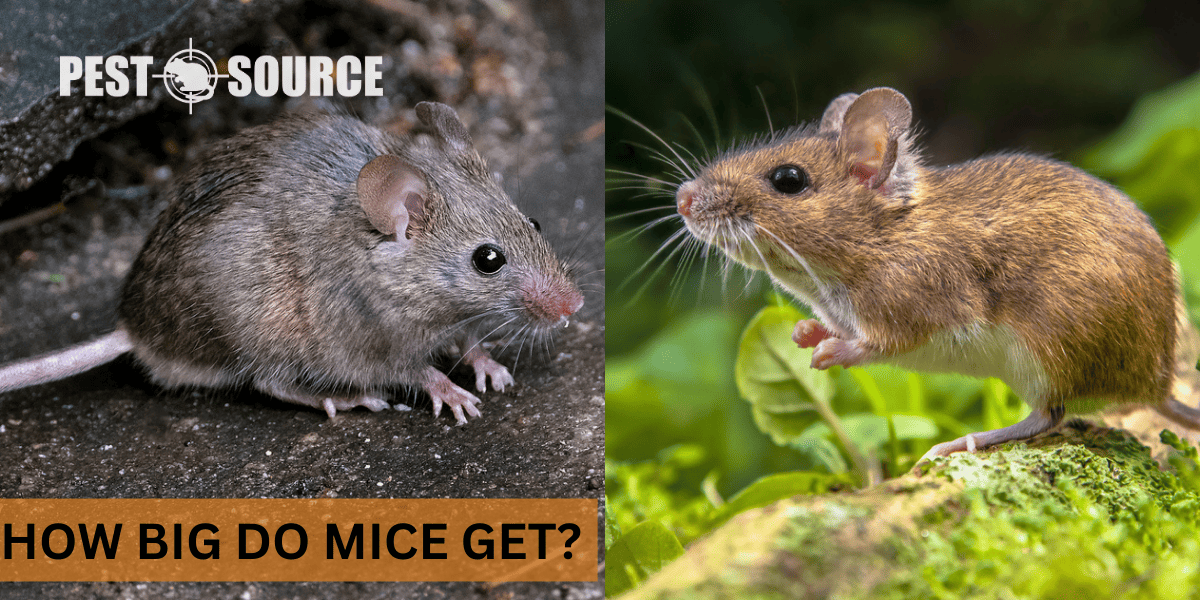Mice typically grow to about 3-4 inches in body length, not including the tail. Discover the factors that influence their size and why understanding their physical dimensions is important in identifying and managing mouse populations.
POINTS
- An adult house mouse’s size typically spans 5 ½ to 7 inches in length, including tail, and its weight ranges between 0.5 and 1 oz. However, size can vary based on the species, age, and other individual traits.
- Mice have distinctive features such as a round body shape, large ears, tiny dark eyes, and fur colors ranging from brown to grey to black. These characteristics can vary across different species.
- Field mice are typically larger than house mice. For instance, the Wood mouse (Apodemus sylvaticus) reaches about 3.5 inches in body length, while the Deer mouse (Peromyscus maniculatus) can be anywhere between 2.5 and 4 inches long.
- The size of a mouse can be influenced by a variety of factors, including genetics, gender, nutrition, environmental conditions, population density, predation, diseases and parasites, stress levels, reproductive status, hormonal levels, age, and social structure.
- Understanding mouse sizes is key in fields like pest control and scientific research, as it influences identification, health assessment, control-measure selection, experimental design, and conservation efforts.
Why Understanding Mouse Size is Important?
How do Humans Typically View Mouse Size?
Most people perceive mice as small creatures, typically picturing the common house mouse. However, it’s important to note that the size can vary with the species, age, and individual traits of mice.
Why is it Important to Recognize the Variations in Mouse Sizes?
Recognizing the variations in mouse sizes is important for several reasons:
- Identification: Different species of mice can cause different types of problems, and their size can often be a good clue to their classification. For example, spotting a bigger mouse might indicate the presence of a rat instead.
- Pest Control: Knowing the size of the mouse can help in choosing the correct traps and control measures. If you have a small mouse infestation, a larger trap might not be triggered by their weight.
- Health Indicator: The size of a mouse can often tell you about its health. A smaller than usual mouse might be malnourished, sick, or young.
- Animal Research: In scientific research, understanding the natural size variations among mice can be essential for designing experiments, making accurate conclusions, and ensuring the health and wellbeing of the animals.
- Conservation: Understanding size differences can help in conservation efforts, as it can reflect the health of the mouse’s population or habitat within a specific area.
How can Knowledge of Mouse Size Influence Areas such as Pest Control Or Research?
Knowing the size of mice is critical in areas like pest control because it influences the choice of control measures.
For instance, larger mice might escape from small traps, which would render the pest control measures ineffective. Similarly, in research, a clear understanding of mouse size across different species can provide crucial insights into their genetics, evolution, lifestyle, and predictive behavior patterns.
What Are the General Dimensions of the Common House Mouse?
When visualizing a mouse, we typically think of the small, quick, and often unwelcome house mouse (Mus musculus). So, what does a typical house mouse look like?
What is the Typical Size of an Adult House Mouse?

The size of an adult house mouse can vary, but generally, they fall within a specific range. Typically, the combined head and body length of an adult house mouse measures about 3 to 4 inches (7.5 to 10 cm). The tail adds an additional 2.5 to 4 inches (6.5 to 10 cm), making the total length around 5 ½ to 7 inches.
How Big Can a House Mouse Get?
Including the tail, a house mouse can reach up to 7 inches in length. Regarding weight, house mice usually range between 0.5 and 1 oz (14 to 28 grams), although this can vary.
How Big are Male Mice Compared to Female Mice?
In most rodent species, including the common house mouse, males tend to be slightly larger than females. However, this discrepancy is typically quite small and can often be hard to notice without comparing several individuals side by side.
What Do Mice Look Like?
Now that we understand the general size of house mice, let’s delve deeper into their distinguishing characteristics. This can be particularly helpful in identifying and differentiating them from other rodent species.
What are the Distinctive Features of Mice?
Mice have a recognizable round body shape, large ears, and tiny dark eyes. Their fur color varies from one species to another, ranging from brown to grey to black. A lighter-colored underbelly is also characteristic of mice.
Do Mice Have Big Ears?
Yes, mice do have big ears relative to their body size. This gives them an excellent sense of hearing which they use primarily to avoid predators and navigate their environment.
Do Some Mice Species Have Particularly Big Ears?
Yes, some species of mice have larger ears than others. For example, the Long-eard jerboa is a distinct species known for its comically large ears.
Do Mice Have Big Eyes?
Mice have relatively large eyes when compared to their body size. This structure aids them with their nocturnal lifestyle by enhancing their night vision.
Which Mice Have Notably Large Eyes?
The Spiny mouse is an example of a species with larger eyes relative to their body size. Their excellent night vision allows them to expertly navigate in the dark.
Do Mice Have Big Feet?
Mice do have large hind feet, suitable for jumping and climbing, relative to their front feet.
Are There Mice with Unusually Big Feet?

Yes, certain species like the Jumping mice or Jerboas have noticeably larger hind feet, adapted for their hopping mode of movement.
How do Features Like Fur Color Vary Across Different Species of Mice?
Fur color in mice often varies based on the species. The common house mouse, for instance, has fur that ranges from brown to grayish-black, with a lighter-colored underbelly. However, Field mice may have a reddish or yellowish-brown coat, while Deer mice have a distinct white underbelly and brown upper body. The colors often serve as camouflage against predators or environments, varying depending on the species’ native habitat.
What Are the Other Common Species of Mice and Their Sizes?
Outside of the common house mouse, there are numerous other species of mice, each with its unique characteristics and sizes. Let’s take a closer look at a couple of examples.
What is a Field Mouse and How Does it Differ to House Mouse When it Comes to Size?
Field Mouse is a general term used to describe several larger species of mice found typically in fields or outdoor environments. For example, in the UK, the term usually refers to the Wood mouse, while in the US, it might refer to various species of the Peromyscus genus.
How Big Can Field Mice Get?
The size of field mice can vary depending on the species:
Wood Mouse (Apodemus sylvaticus):

Common in the UK, the Wood mouse’s body length is typically around 3.5 inches (9 cm), with a tail approximately the same length. They typically weigh between 0.7 and 1 oz (20 to 28 grams).
Deer Mouse (Peromyscus maniculatus)

Common in the US, the Deer mouse has a body length of 2.5 to 4 inches (6.5 to 10 cm) and a tail length of 2 to 5 inches (5 to 12.5 cm). They usually weigh between 0.5 to 1.2 oz (14 to 34 grams).
As the data shows, field mice can be slightly larger than house mice, reaching lengths of up to 10 inches, including the tail – although this will largely depend on the specific species.
What Factors Influence the Size of a Mouse?
Just like with other animals, several factors can contribute towards determining the size of a mouse. These elements can affect a mouse both before and after its birth. In this section, we will delve into these factors in more detail.
Genetics
Genetics hold a significant position in determining the size of a mouse. Different species and strains come with different average sizes. Even within a species, genetic variations can lead to size differences.
Gender
As mentioned in the previous sections, male mice tend to be larger than female mice in most species. However, the difference is usually not significant and might be hard to observe without direct measurement.
Nutrition
Access to a nutritionally rich diet plays a crucial role in the size of a mouse. Mice with consistent and balanced diet access often grow larger than those with inadequate nutrition.
Environmental Conditions
Mice residing in harsh conditions such as extreme cold or heat, or high altitude might develop different body sizes or shapes. For instance, mice in colder regions may grow a larger body mass to retain heat.
Population Density
A dense mouse population can lead to intense competition for resources. This limited access to food and increased stress can hinder typical growth, contributing to smaller mouse sizes.
Predation
In areas with high predation risks, mice may alter their behavior, affecting their growth. Faster growth to quickly reach reproductive maturity might be promoted if the life expectancy of mice is lower.
Disease and Parasites
Illness or parasitic infections can inhibit growth and reduce the overall size of a mouse, especially if the infection happens during the animal’s growth phase.
Stress
Chronic stress, from frequent handling, environmental conditions, or social interactions (like dominant/subordinate dynamics), can negatively affect mousy growth.
Reproductive Status
Reproducing females, especially if they are nursing, demand increased nutrition and may appear leaner compared to non-reproducing females.
Hormonal Levels
Hormones play a critical role in development and growth. Any change in hormonal levels, either naturally due to external factors such as stress, can impact the size of a mouse.
Age
Mice, like other mammals, grow as they age. The mouse’s size will increase as it transitions from a juvenile to an adult stage and will plateau upon reaching adulthood.
Social Structure
In some mouse species, individuals with a dominant position may have better access to resources or stress less, influencing their growth and size compared to their subordinate peers.



